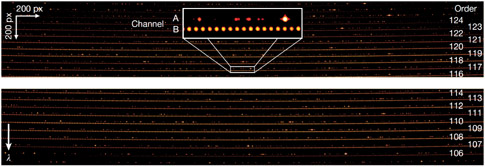
Frequency Combs to Measure Cosmic Velocities
High resolution laser spectroscopy advanced a significant step forward when frequency combs were introduced to directly measure the frequency of the laser light that is used to excite atoms, ions or molecules. A prerequisite for this approach seems to be the coherence of the light source whose frequency is measured. On the other hand, there is a class of incoherent light sources that are scientifically interesting, but cannot be measured with coherent lasers. The most prominent of these light sources are astronomical objects like stars, gas clouds, galaxies and quasars. One of the possible exciting measurements is to determine the velocities of these objects from the Doppler shifts that their motion relative to the earth imposes on their spectra.

Spectrographs connected to telescopes have been used for that purpose, and they were typically calibrated against thorium-argon lamps or iodine absorption cells. The new generation of spectrographs such as the High Accuracy Radial velocity Planet Searcher (HARPS) however, are limited in reproducibility by these calibration methods. In addition, the lines of thorium-argon lamps are sparse so that non-linearities of the calibration curve of the spectrograph cannot be determined with high confidence. For this reason, we are now using a frequency comb that is directly stabilized to an atomic clock. The main challenge of the frequency comb calibration method is to provide a mode spacing (i.e. repetition rate) that can be resolved by the spectrograph. The typical value at which astronomical telescopes achieve the best signal to noise ratio is around 20GHz. Our approach is to start out with a much lower mode spacing and use a Fabry-Perot etalon as a periodic filter to successively thin out modes.
Hunting for Exoplanets
Astronomers measure Doppler shifts as well as optical detunings in terms of the corresponding velocities. Extrasolar planets are directly visible only in rare cases with very large orbits. It is difficult to resolve and to shield scattered light of the bright host star from the faint light of the planet. Indirect methods, such as the radial velocity method, have been used for the discovery of many exoplanets. With this method one observes a periodically varying Doppler shift of the Fraunhofer lines of the host star which is due to the recoiling motion caused by the orbiting planet(s). The easiest detectable planets are so called hot Jupiters, that are giant planets with a large gravitational pull in a close orbit, that usually takes a few days only. In contrast the required velocity resolution for detecting an earth-like planet that goes around a sun-like star is 9cm/sec, i.e. v/c=3x10-10 in relative units. The frequency accuracy of a frequency comb is very helpful to achieve this goal. We have been testing our so called "astrocombs" at the High Accuracy Radial velocity Planet Searcher (HARPS) at the La Silla Observatory, Chile.

Detecting Cosmic Acceleration
Another interesting application of astrocombs might be the detection of cosmic acceleration (not the cosmic expansion!) that has been inferred from other observations. When monitoring the cosmic red shift for a few years, it may become possible to observe this speed up in real time, if the stability and resolution of astrocombs could be extended over these very long observation periods. Since the frequency comb allows to refer to the Cs atomic clock such such a measurement seems feasible. A direct observation of cosmic acceleration could be decisive on whether or not dark energy, together with general relativity, constitute the proper model, or if we have to seek out for new explanations.
Team
This work is a collaboration between MPQ, the European Southern Observatory and Menlo Systems GmbH.
Current MPQ Members
Rafael Probst, Yuanjie Wu, Thomas Udem, Ronald Holzwarth
Former MPQ Members
Tobias Wilken, Tilo Steinmetz, Constanza Araujo-Hauck
Further Reading
T. Wilken, G. Lo Curto, R.A. Probst, T. Steinmetz, A. Manescau, L. Pasquini, J.I. González
Hernández, R. Rebolo, T.W. Hänsch, Thomas Udem, Ronald Holzwarth, A spectrograph for Exoplanet
Observations Calibrated at the Centimetre-per-Second Level
Nature 485, 611 (2012)
Video abstract about comb calibration with a single mode fiber.
